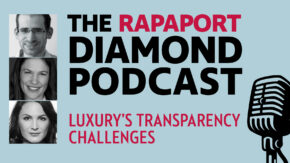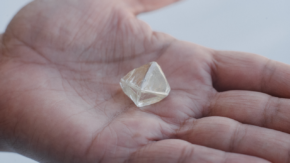Lab-grown diamonds, sustainability were hot topics at Phoenix and Tucson fairs.
Activity was strong at last week’s Centurion Jewelry Show in Phoenix, Arizona, creating an air of optimism among attendees.
Despite the wave of recession talk in the past two years, retail buyers and exhibitors were encouraged by the moderating inflation figures and strength in the job market. The invitation-only fair for luxury retailers and manufacturers, which took place January 28 to February 1, was humming with activity.
The atmosphere was a bit more subdued at the AGTA GemFair Tucson, which ended February 4. The gem traders were not discussing business, yet the estate-jewelry and watch dealers and the jewelry designers were busy with buyers.
At both Centurion and AGTA, the issue on the minds of creators, manufacturers, dealers and retailers was lab-grown diamonds — with an almost universal consensus against them. The other hot topic was the confusing quagmire of sustainability, which has gained in urgency as the Federal Trade Commission (FTC) is updating its “Green Guides,” designed to help marketers ensure that the environmental claims they are making are true and substantiated.
Lab-grown diamond restraint
There is near-unanimous agreement that lab-created stones are bad for the industry and consumers. However, the players also understand that they are part of the jewelry mix. One New Jersey-based retailer, speaking for many, said they reluctantly sold lab-grown diamonds because if they didn’t, they would lose about 20% of their business. Many expressed disappointment with the Gemological Institute of America (GIA) for grading lab-grown diamonds, which they say gives these gems undeserved legitimacy.
At Centurion, exhibitor Dominick Gabriel, cofounder of Gabriel & Co., noted he had seen the impact of lab-grown diamonds. “We are seeing lab-grown diamonds coming into play,” he said. “Before, round diamonds were the norm because they hold their value better. Because of man-made diamonds, we are seeing more fancy shapes like emerald, oval and radiant. And we are seeing a move from 1-carat diamonds to 2 or 3 carats.”
Michael Deal, business growth leader at Tacori, a Centurion exhibitor that specializes in bridal and fine fashion jewelry, has natural and lab-grown diamonds collections. He, too, has observed an increase in requests for larger diamonds as lab-grown gains traction.
“It’s definitely moving the needle,” he commented. “One-carat diamonds are now 1.5 carats, and we are seeing more 2 carats and above.”
Natural Diamond Council (NDC) CEO David Kellie, who attended Centurion, said it was too early to predict the overall effect lab-grown will have on the industry. However, he added, a two-tiered system seemed to be developing, with serious jewelry buyers choosing natural diamonds and lab-grown being more of an accessories purchase. It’s important for consumers to know the difference between the two so they can retain consumers’ trust in natural diamonds. One major aspect is that lab-grown diamonds decline in value once they are purchased.
Defining sustainability
There is an abundance of confusion on what sustainability is and how to ensure that products being sourced and sold through the supply chain maintain an ecological balance. Just as important is how sustainability is ultimately defined and how it can be documented.
This was an important topic at the AGTA GemFair, particularly after the January announcement that the American Gem Trade Association (AGTA) has formed a committee to define and standardize contemporary industry terms in sustainability. The committee’s launch coincides with the FTC’s call for public comments for updates to its “Green Guides.”
Working with the FTC within the jewelry industry usually falls under the guidance of the Jewelers Vigilance Committee (JVC). Whether these two organizations will work together or separately is unknown. The new deadline for public comment is April 23. The JVC’s own extended deadline for submissions is March 10.
“With everyone touting that they are the most responsible, who is to prove them wrong?” asked gemologist Gary Roskin of the Roskin Gem News Report. “It pretty much affects whether or not you should buy a Burmese ruby, sapphire, jadeite, peridot, a Sri Lankan gemstone, Afghanistan lapis, an emerald, etc.”
He continued, “And then there are the labs who identify ‘country of origin,’ as if it’s from Colombia, then it’s ethical. Gems are not ‘ethical’ or ‘not ethical.’ It’s the people who buy and sell them.”
Or as one prominent gem dealer and jewelry designer said during the AGTA show, “I’ve never met an ethical gem.”
“A lab report stating a country does nothing more than say, ‘Yep, we think we know where it was mined,’” Roskin added.
Jenna White, a PhD student at the Colorado School of Mines, held a presentation at the AGTA show to guide retailers on how they should discuss sustainability with their customers. One thing she stressed to jewelers is to be honest in what they know about the traceability and ethical sourcing of their products. If you don’t know the origin or the supply chain of a product, tell the customer.
“We have to be clear on what we know and what we don’t know,” White told attendees.
Niveet Nagpal of Omi Privé and Omi Gems, who exhibited at Centurion and AGTA, said that being sustainable should include sharing the wealth of the colored-gemstone industry with the miners, who had historically profited the least.
“We live a beautiful life surrounded by beautiful jewelry,” he pointed out. “We should help give back that value to the miners and mining areas.”
Also on hand at AGTA Gemfair was Toby Pomeroy, a prominent goldsmith and jewelry designer, and founder of Mercury Free Mining (MFM), an organization trying to halt the use of highly toxic mercury in artisanal and small-scale gold mining.
Pomeroy and inventor John Richmond were showing the Goldrop, a machine that separates gold from dirt through the process of elutriation. So far, it has been successful in the field and through testing at the University of Arizona, Pomeroy reported. More testing is needed, but he described its chances of widespread use as “very promising.”
Image: Attendees at a booth at the Centurion show. (Centurion Photos)



